Animal Well is a moody and cerebral tangle of enigmas that explores puzzle-platforming and non-linear platforming concepts in a dank chasm where mischievous and sometimes malicious animals lurk in the darkness. It begins with a flower blooming to reveal at its core a pink blob with tiny inkspot eyes: the player character. Their birth is witnessed by a squirrel, which scampers away when the player character approaches. Following the squirrel, the player character enters the labyrinthian Animal Well, a warren of tunnels where finding the way out is the least of its innumerable mysteries.
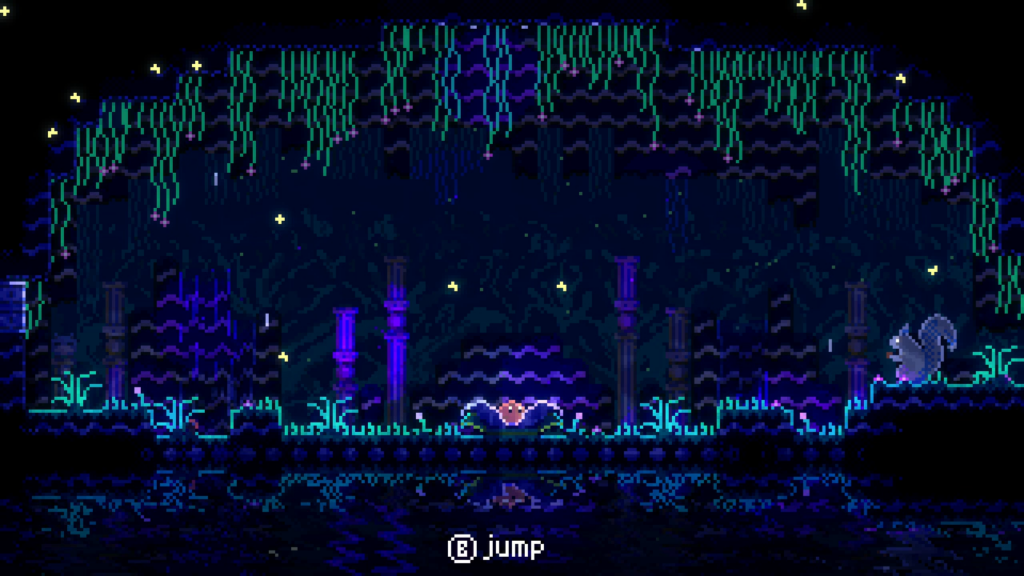
Animal Well is a videogame of layers. Its surface layer is its simplest. There is a familiar, digestible goal that would not feel out of place in any other non-linear platformer. Once that goal is completed, then the credits roll and the videogame is beaten. While working towards this goal, I recognize the seeds of other mysteries beginning to sprout. Pursuing these sprouts to their ends reveals additional layers and Animal Well’s true grand nature.
Animal Well’s first layer is conventional, even predictable. After following the squirrel away from the player character’s birthplace for a few screens, they discover a shrine where statues of a seahorse, a dog, a lizard, and an ostrich stand on top of unlit sconces. Hidden throughout the Well are four flames trapped in glass globes. Finding these flames and returning them to the sconces opens a door at the shrine’s center which leads to a final confrontation and Animal Well’s nominal ending. Experienced non-linear platforming players will find this scenario familiar.
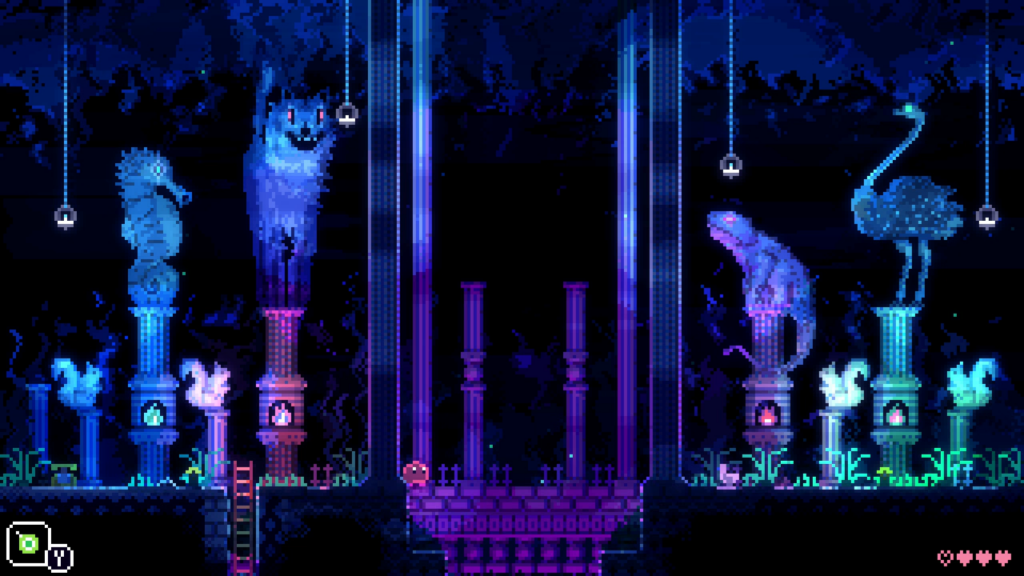
What is unfamiliar is how the player character reaches these flames. Instead of a gauntlet of combat challenges, the platforming obstacles the player character overcomes are almost all puzzle-based. A majority of these puzzles are enabled or embellished by the animals who live within the Well. In order to reach a high door, the player character must jump along a string of bubbles carried by a spout of water emitted from a breaching seahorse. Automated platforms have the direction they travel flipped by disturbing the mice who power them in running wheels. A snake slithers randomly across a room and the player character must scramble across its back to reach an exit without getting crushed between its coils. Everywhere the player character goes they are confronted with problems which require experimentation and thought as much as concentration and skill.
The animal-based platforming puzzles are embellished and complicated by the items the player character discovers while they explore the Well. A bubble wand. A flying disc. A yo-yo. A slinky. These toys, apparently thrown down the Well by careless children, add fascinating new layers to most puzzles.
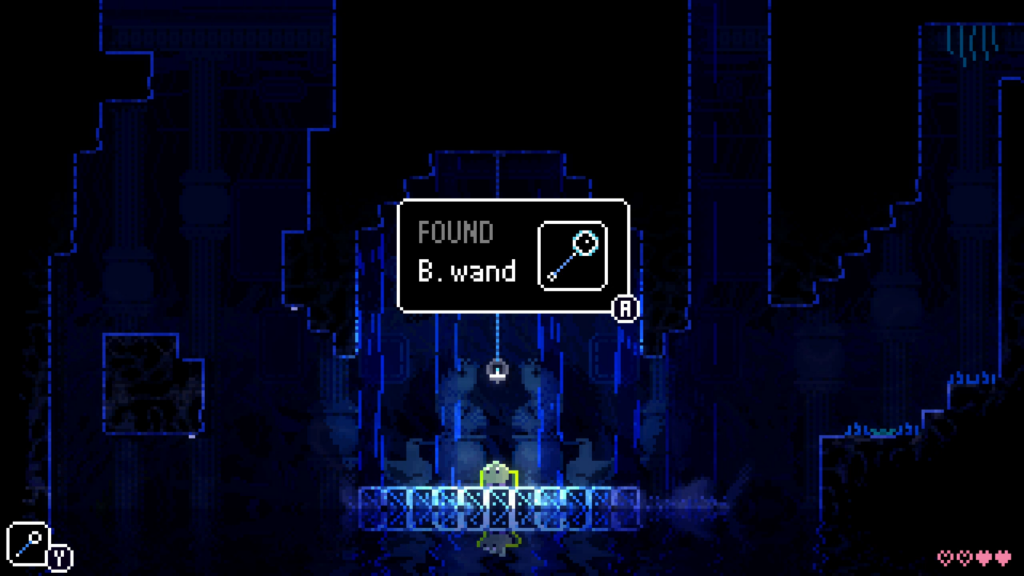
Each toy has a useful and obvious baseline function the player character must exploit to reach new areas. The bubble released by the wand can serve as a temporary platform—a very temporary one, as it begins to sink as soon as the player character jumps upon it. The flying disc ricochets endlessly between any surfaces it touches and can activate certain levers. The yo-yo can also activate buttons, including those at the ends of narrow tunnels it bends and curves through in an improbable mastery of yo-yo tricks. Many of the first layer’s best puzzles involve the slinky, which can walk down stairsets and other tall obstacle courses before coming to rest on pressure plates, requiring the player character to race the slinky to the mechanism it opens elsewhere in the room.
Each toy has additional, hidden functions that only present themselves when it is used in an unorthodox way. Some new functions only come into play when a certain animal is on the screen; many animals prove to be immovable obstacles until the player character visits with a certain toy in hand and uses it in a certain way. Nothing in Animal Well tells me what these additional functions are. The only way to discover these secret functions is to experiment, to try using a toy in a new way and see what happens.
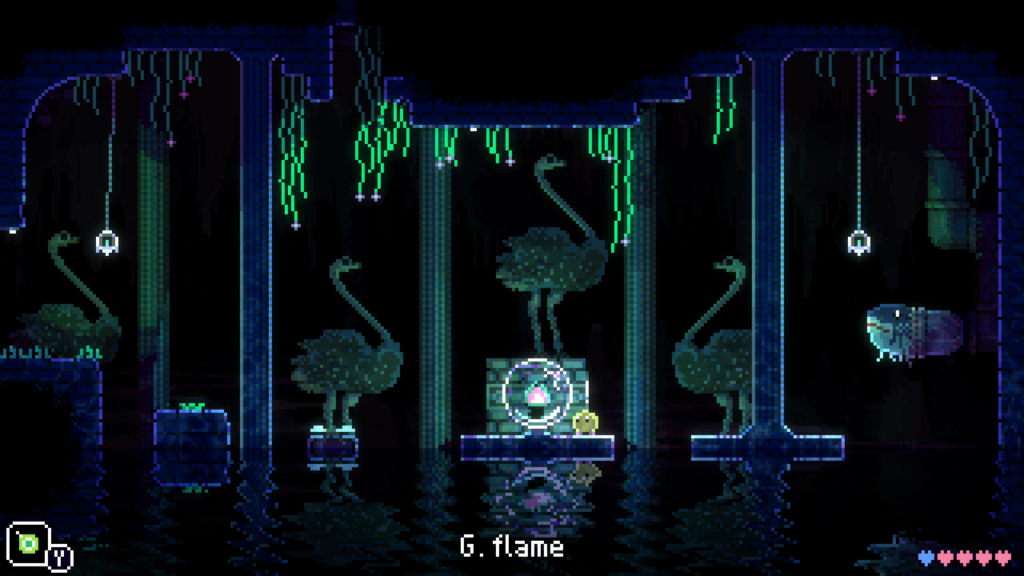
The most impressive part of this first layer’s design is its commitment to non-linearity. Typically when I describe a non-linear platformer, I mean to invoke a world which may be explored independently, without guidance, but there is still a prescribed path the player character must follow to reach its ending. These worlds are non-linear in that they must be investigated, often backtracking multiple times over the same areas until the intended path to the next goal is found.
Animal Well’s first layer expands on this concept into true non-linearity. During my time, my player character discovers the bubble wand first, stumbles upon the yo-yo second through happenstance, then finds and delivers the ostrich flame. There’s little besides ingenuity and choosing to travel in a different direction that stops another player from finding the flying disc or slinky first and then the dog or seahorse flame. Every player’s route through Animal Well’s first layer will be their own personal adventure, totally unique from any others, filled with different discoveries, difficulties, and disasters.
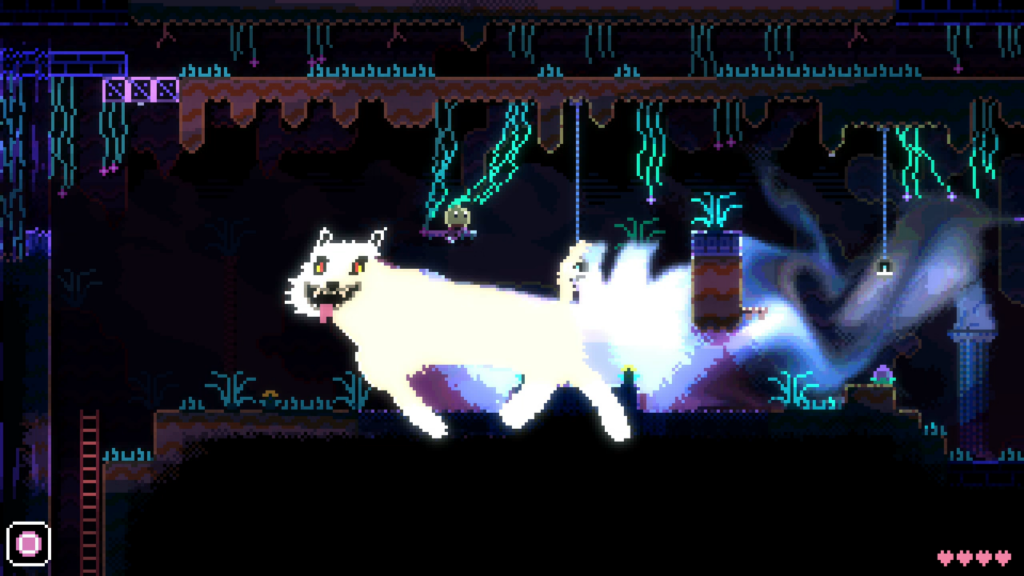
Finding and exploiting the toys to solve Animal Well’s surface level puzzles, find the four flames, and deliver them to the shrine at the Well’s center is enough to finish the first layer. This alone is one of the better puzzle-platformers I’ve played and one of the best videogames of 2024 so far. But once the player character has found the secret hidden in the heart of the Well, there are still additional layers to uncover.
The second layer will still be familiar to players experienced in non-linear platformers. Most contain additional collectables hidden across the environment. Finding these collectables requires skillful use of the player character’s toys and careful exploration of every corner of the world.
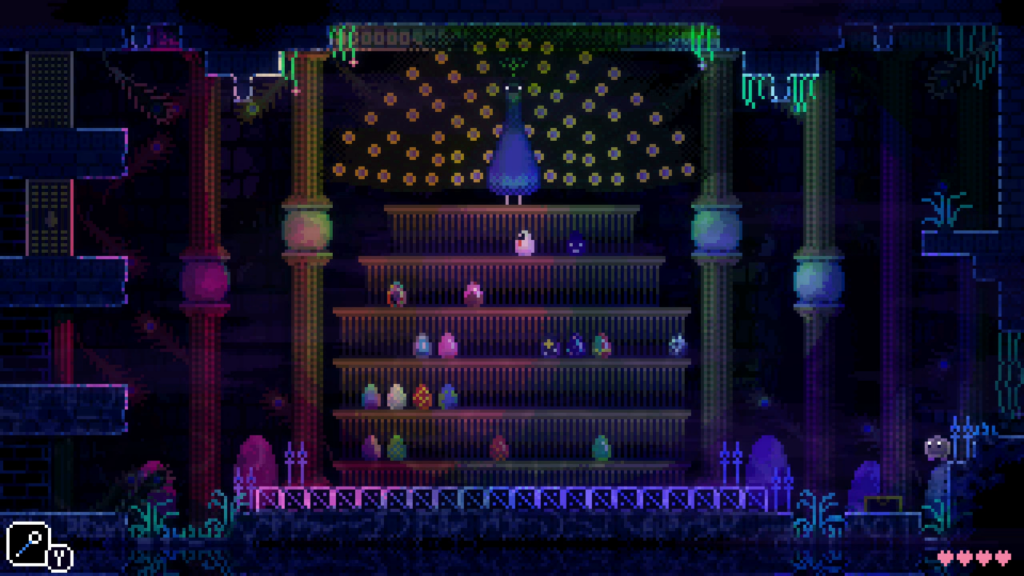
Animal Well is no different. It contains sixty-four eggs hidden in chests across the Well. Some of these chests become available upon the solution of a puzzle. One egg is revealed when the player character uses three levers to manipulate a wave form diagram until it intercepts three static points; this puzzle is totally unlike any other in the Well, resembling something from a 90s adventure videogame more than an indie puzzle-platformer. Other eggs are more conventionally stashed in hidden rooms which only appear when the player character walks into them. The entrances to these rooms are revealed by subtle differences in the wall graphics.
Where Animal Well departs from familiar non-linear platforming ideas is the collectable eggs confer no useful advantages to the player character. They do not grant increased durability; the player character must survive all of the Well’s dangers using their default health bar. They do not reward new or improved offensive power; the player character is non-violent, able to repel aggressive animals with the light from a candle or a noisy firecracker, but no creature they encounter is harmed.
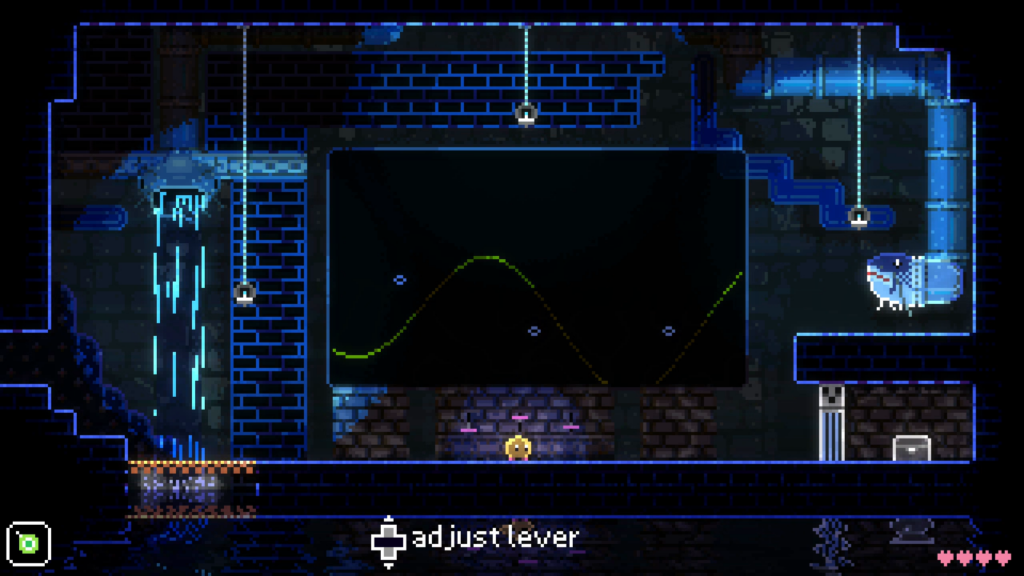
The reward for finding eggs is to make it easier to find more eggs. Until the player character collects all of the Well’s lost toys, they encounter many puzzles they are unable to solve. Frustratingly, there is initially no way to mark on the in-game map where these puzzles are, forcing me to rely on memory or handwritten notes to remember these locations. Finding eggs unlocks the ability to make these marks directly onto the map, first with stamps, and then with a freehand scrawl. Animal Well is insistent that I prove my capability and determination before it gives me any tools to make exploration easier.
These map-marking tools are essential because Animal Well spurns many non-linear platforming presentation conventions. Different areas in the Well are clearly themed but they are not separated by elevators or thick walls. A dark cave where bioluminescent lichen dangles from the ceiling is connected directly to a sturdy brick area filled with mechanical contraptions. Wandering from one area into another without realizing it is common; getting lost is not only easy, it seems expected. It’s the entire point.
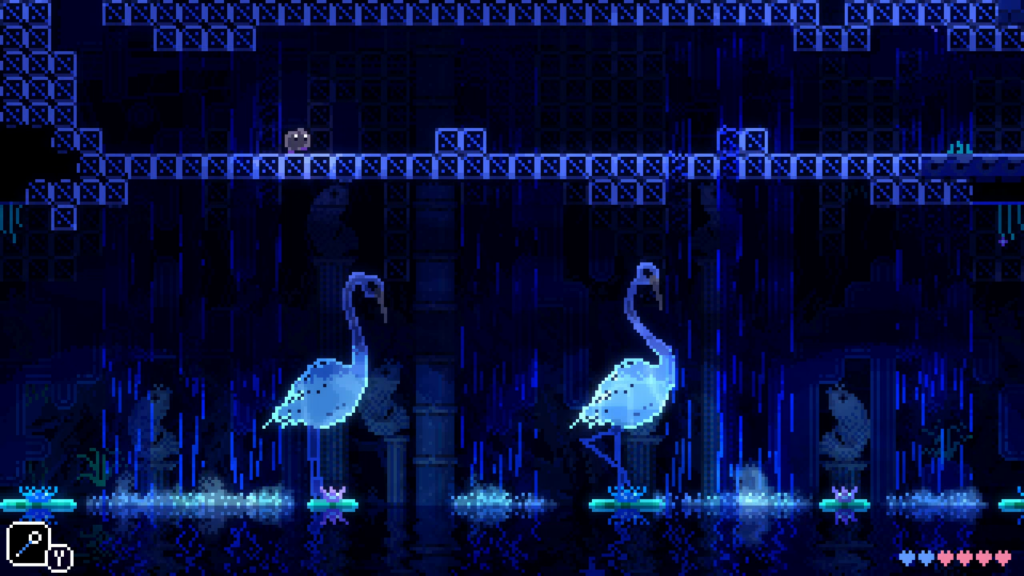
I believe Animal Well uses this sprawling and interconnected design to influence how it is discussed in online communities. Areas cannot be readily identified by simply looking at what they’re called on the map. They must be recognized and described based on what they contain.
Knowing animal species by sight helps to accomplish this task. Aside from the living animals themselves, statues of animals also litter the environment, serving as valuable guideposts. If I were to direct another player on how to obtain a particular toy, flame, or egg, I would have to tell them “climb up the ladder near the penguins statues” or “keep going right from where cranes fish between lily pads.” Even now, I can visit Reddit or videogame forums and see players who are forced to examine and recognize the Well’s most minute and intricate details simply to talk about it with others. This may be its greatest accomplishment.
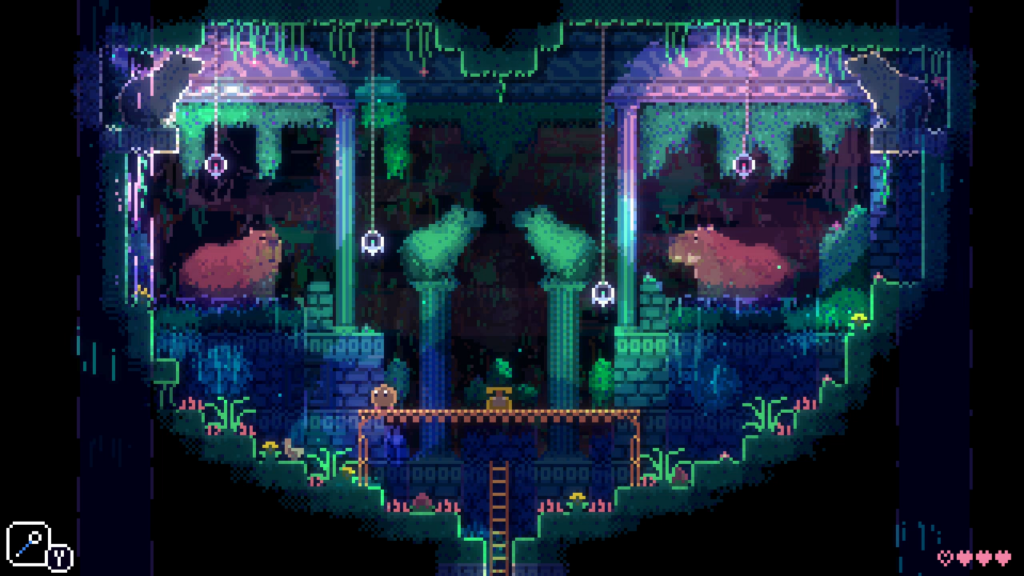
Beneath the four flames and the sixty-four eggs is Animal Well’s final and most inscrutable layer. Finding the flames requires effort. Finding the eggs requires persistence. Uncovering the secrets in the third layer requires nothing less than methodical cataloging of every detail in the foreground and background of almost every screen.
While completing the first layer it’s easy to dismiss the details around every space in the Well. They appear mostly decorative, adding to the mystique and majesty of the environment but doing little to help the player character achieve their primary goal. I can even choose to accept this assumption as fact, opening the shrine and believing my time with Animal Well is finished after the credits roll. If I linger and accept these details are more than merely decorative then I recognize that the player character’s adventure and my understanding of the Well has only just begun.
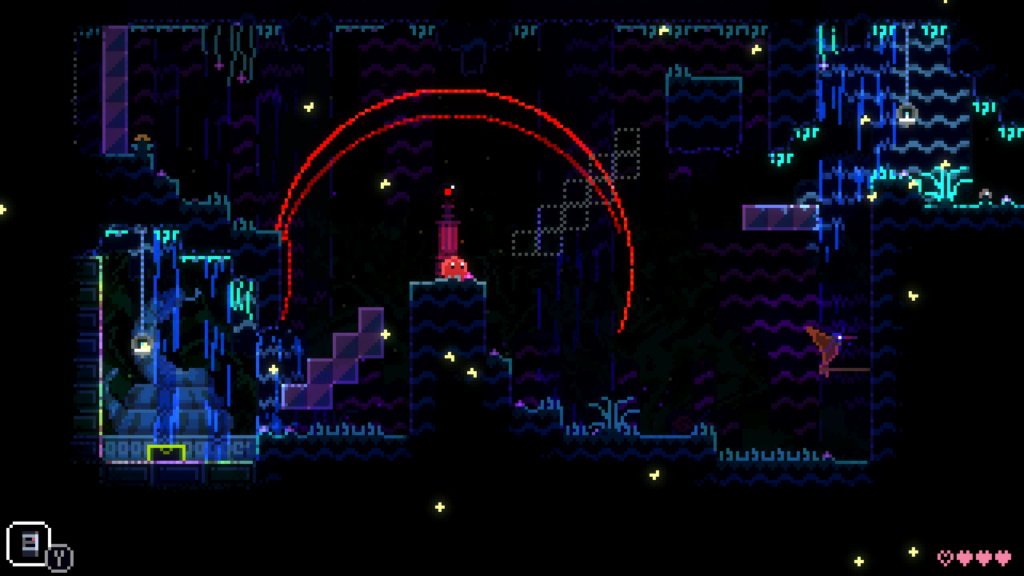
One of the first third layer discoveries the player character makes is a new toy. Sequestered in an early, out-of-the-way tunnel that is easy to spot and easier to forget, the remote gives long distance control over doors and platforms that could previously only be toggled by activating a switch. It isn’t until the player character has this toy in their possession that I notice almost every single room containing a switch also contains a tower in its background with a red light at its top. Each time the remote is used, the red light flashes. Once I notice these towers I am inspired to revisit every area in the Well to find all of them and see what happens when the remote is activated near them. Picking up the remote even expands the size of the player character’s inventory screen when it is picked up, revealing several new blank spaces to suggest just how much larger the Well is than it first appears and how many new toys will be found there.
This discovery makes me question everything I have taken for granted within the Well. A bitmap drawing of a rabbit on a wall seems to be just a signpost, but what if its composition and various imperfections have a greater meaning? The wave form diagram puzzle seems like a dated and inexplicable outlier compared to the Well’s other puzzles; might it give me a clue if I used a computer program to turn the diagram into an actual sound? During the search for the flames, the player character encounters rabbits, kangaroos, and cats, none of whom do anything but add to the atmosphere. They must do something. But what?
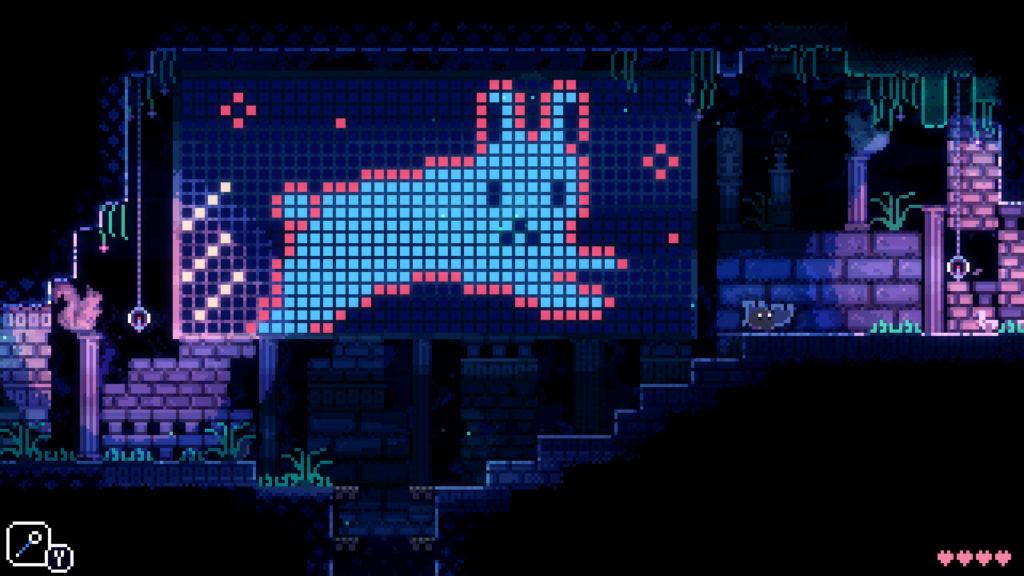
Animal Well’s primary developer estimates it will take years for all of the secrets they have hidden in the Well to be uncovered. Looking at just a short list of details which seem significant but have no obvious purpose, I believe them.
Animal Well is a remarkable feat of videogame design. Even if it only consisted of its topmost, most conventional first layer, a non-linear puzzle-platformer that emphasizes self-guided exploration and creative problem solving, I would insist that everyone play it. This is only the beginning of what lurks in the Well. Its remaining secrets and the way it exploits cryptic and deliberately disorienting level design to force collaborating players to describe the environment to each other is where its true strengths lie. I will not predict or even suspect what its online community will discover in the future. It will be fascinating to find out.